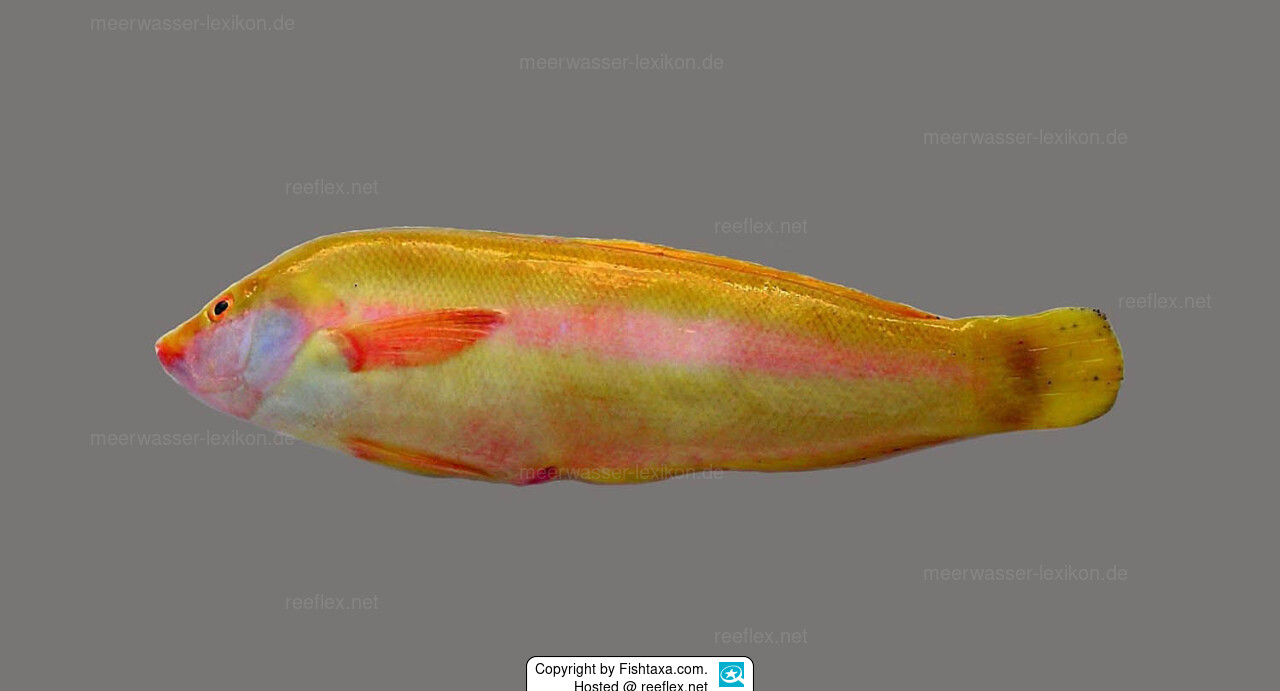Info
The yellow wrasse, Coris flava, was described from La Réunion in the southwestern Indian Ocean, based on two specimens collected in 2006 and 2012 off the northwest coast of the island in 200-250 m depth.
The new species was published in FishTaxa in December 2021.
Initial Stage (Initial Phase):
The body of the wrasse in the initial phase is white, the dorsal third pale yellow, with gray scale margins.
The scale margins in the middle and posterior parts of the body are gray; there are 13 faint, horizontal, bluish lines on the middle of the body;
The eye is bright orange and surrounded by a yellow rim.
The upper distal part of the operculum is pink.
Dorsal and anal fins are yellowish, distal margins gray, first dorsal fin membrane dark gray.
Pectoral fin is translucent, upper base pink, upper distal part dark gray.
Pelvic fins are white basally, yellowish distally.
Terminal phase:
Head and body are golden yellow in terminal phase, sides of body show a pinkish band extending from behind tip of operculum to middle of caudal fin base.
The jaws are bright orange, and the cheeks and lower portions of the operculum are pink;
The eye is bright orange.', the area around the anus pink.
The dorsal and anal fins are orange-yellow, the caudal fin is yellow with gray margins;
Pectoral fins are reddish orange, pelvic fins yellowish orange.
Etymology:
Flavus (Latin) means "golden yellow"; the name refers to the characteristic yellow coloration of the two phases of this species.
The species name has a feminine ending (flava) when in genus Coris.
Scientific source:
Fricke, R., Durville, P. 2021.
Coris flava, a new deep water species of wrasse from La Réunion, southwestern Indian Ocean
(Teleostei: Labridae). FishTaxa 22: 23-36.
Jumping guard
A jumping guard prevents (nocturnal) fish from jumping out.
Wrasses, blennies, hawkfishs and gobies jump out of an unprotected tank in fright if their night rest is disturbed, unfortunately these jumpers are found dried up in the morning on carpets, glass edges or later behind the tank.
https://www.korallenriff.de/en/article/1925_5_Jump_Protection_Solutions_for_Fish_in_the_Aquarium__5_Net_Covers.html
A small night light also helps, as it provides the fish with a means of orientation in the dark!
The new species was published in FishTaxa in December 2021.
Initial Stage (Initial Phase):
The body of the wrasse in the initial phase is white, the dorsal third pale yellow, with gray scale margins.
The scale margins in the middle and posterior parts of the body are gray; there are 13 faint, horizontal, bluish lines on the middle of the body;
The eye is bright orange and surrounded by a yellow rim.
The upper distal part of the operculum is pink.
Dorsal and anal fins are yellowish, distal margins gray, first dorsal fin membrane dark gray.
Pectoral fin is translucent, upper base pink, upper distal part dark gray.
Pelvic fins are white basally, yellowish distally.
Terminal phase:
Head and body are golden yellow in terminal phase, sides of body show a pinkish band extending from behind tip of operculum to middle of caudal fin base.
The jaws are bright orange, and the cheeks and lower portions of the operculum are pink;
The eye is bright orange.', the area around the anus pink.
The dorsal and anal fins are orange-yellow, the caudal fin is yellow with gray margins;
Pectoral fins are reddish orange, pelvic fins yellowish orange.
Etymology:
Flavus (Latin) means "golden yellow"; the name refers to the characteristic yellow coloration of the two phases of this species.
The species name has a feminine ending (flava) when in genus Coris.
Scientific source:
Fricke, R., Durville, P. 2021.
Coris flava, a new deep water species of wrasse from La Réunion, southwestern Indian Ocean
(Teleostei: Labridae). FishTaxa 22: 23-36.
Jumping guard
A jumping guard prevents (nocturnal) fish from jumping out.
Wrasses, blennies, hawkfishs and gobies jump out of an unprotected tank in fright if their night rest is disturbed, unfortunately these jumpers are found dried up in the morning on carpets, glass edges or later behind the tank.
https://www.korallenriff.de/en/article/1925_5_Jump_Protection_Solutions_for_Fish_in_the_Aquarium__5_Net_Covers.html
A small night light also helps, as it provides the fish with a means of orientation in the dark!







 Fishtaxa.com
Fishtaxa.com






























